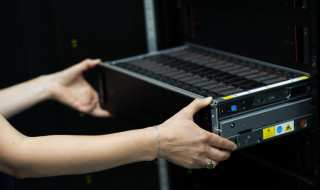Compute

Why at SURF?
Easy access to unique facilities
Tailored support and expert advice
Collaborate in a secure environment
Choose the right service for your project
High-performance computing (HPC)
Dataprocessing
Cloud computing
Which computing service suits your research question?
Wondering which infrastructure best fits your research? There’s no one-size-fits-all answer. That’s why our advisors always start with tailored advice on the most suitable infrastructure for your needs. Several key factors come into play in making this decision.
More support: consultancy and training
Consultancy
Cloud Research Consultancy
Visualisation: more insight into your data
Training

Scientific datasets, models and simulations are becoming increasingly large and complex. Whether in high-energy physics, climate research, drug development or the social sciences,large-scale computing power is essential for cutting-edge research.
Large data sets and AI
Our state-of-the-art computing infrastructure supports the processing and analysis of vast amounts of data, for example, from scientific instruments like telescopes or satellites. It also enables complex simulations and digital twins that help us better understand the world around us. In addition, our systems are increasingly used to train AI models, for applications in healthcare, industry and agriculture.
European ecosystem
SURF's computing infrastructure is part of a European ecosystem that connects and complements international, national and local systems. Through SURF, researchers can take the next step towards accessing international facilities offering the highest levels of computing power and fostering international collaboration. Our services are also closely integrated with essential components such as high-performance network connections and facilities for secure, large-scale data storage.
Computing power in practice
Case study
Turn that noise down!
Together with his team of researchers in Delft, Frits de Prenter studies the sound caused by airflows when they come into contact with objects. This research, which requires considerable computing power, is contributing to the development of quieter aircraft, drones, and wind turbines.Story
AI lets scientists work magic with language
"I can't remember a time when I wasn't interested in language," says linguist Antal van den Bosch. "It is an instrument with wondrous properties. When I learnt a new language in high school, it gave me a kind of key to another world." Nowadays, he finds the magic in artificial intelligence.